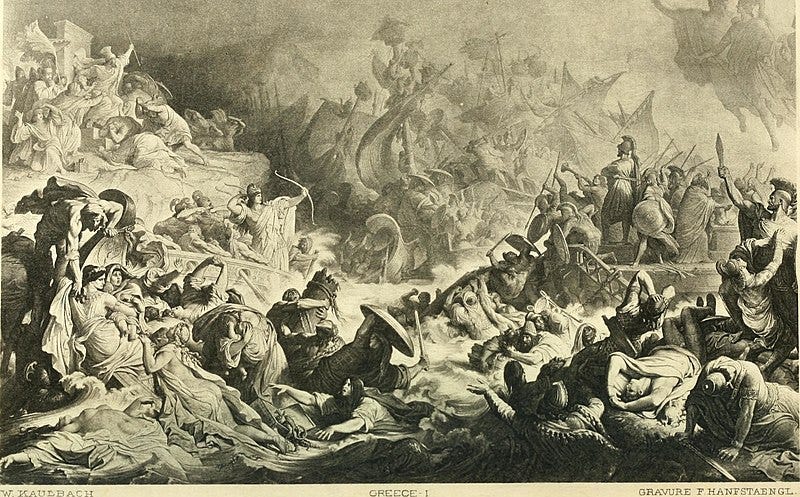How Joseph Campbell’s Monomyth Tells Us Who the Badguys Are
All the problems of our world can be summed up in one sentence: a theme found in every myth across the world.

Our culture is obsessed with heroes, and this obsession is nothing new. For thousands of years, human beings have invented devils and the gods that fight them. We have placed kings and prophets on pedestals of gold, bowing down in supplication.
But, everything a hero represents exists in counterbalance to a darker drive. Within every hero, there is a villain waiting to be born. It is the choice to strive against the inner desolation that creates a hero, just as it is the choice to accept subsummation to our destructive instincts that bears a villain into the world.
The animal brutality of life bears down on us with an atomic weight. There is only a narrow window in reality through which you and I have but galactic seconds to gaze before we are forever snuffed out like candles, forever gone.
In the face of this knowledge, how do we decide right from wrong? How do we choose our own inner hero over our secret villain?
The renowned scholar of mythology, Joseph Campbell, had a few suggestions.
Campbell studied all the mythologies, religious practices, folklore, and fairy tales of the world. He pried into every current of our collective unconscious and discovered a pattern that he termed “the monomyth.”
Chances are, you’ve heard this before, so I won’t rehash old information. Campbell’s work is fascinating, but it’s actually one tiny piece of his work that interests me today.
How is a villain made?

Early in his book, The Hero with a Thousand Faces, Campbell writes that, “the figure of the tyrant-monster is known to the mythologies, folk traditions, legends, and even nightmares, of the world; and his characteristics are everywhere essentially the same” (Campbell, 14).
Think about that. The characteristics of the tyrant monster are, everywhere, essentially the same.
What are these characteristics, then, that cross the divide of culture, geography, and time? What actually makes someone a villain?
“He is the hoarder of the general benefit.” Such a person is “the monster avid for the greedy rights of “my and mine” (14).
Throughout the whole history of human existence, woven into every story that we tell, and every religious text we have invented, is this clarion call: “The inflated ego of the tyrant is a curse to himself and his world — no matter how his affairs may seem to prosper” (14).
Campbell goes on to explore how the villain does not need to be a great king for his shadow to blight the world. Though “the havoc wrought by him is described in mythology and fairy tale as being universal throughout his domain” (14), this havoc can remain close to home.
The tyrant-monster’s own psyche might be the canvas on which he paints misery. Or, he may bring pain and hopelessness upon those within his household, or to those whom he greets as supposed friends.
These commonplace villains are merely lesser symptoms of the same inflated ego, the same greed. An ego unchallenged, unchecked by any internal processes. Though such a person may cause damage on a less-grand scale, the potency of the damage that they do create is no less tragic for its smaller size.
And, sadder still, all such tyrant-monsters are “self-terrorized, fear-haunted” by an environment they view as antagonistic and frightening. Yet, the fear and anger which such people feel are, primarily, “the reflections of the uncontrollable impulses to acquisition within himself” (14).
Where the hero is “the [person] of self-achieved submission” (15) to the forces of the universe, the villain is the “giant of self-achieved independence” (14) from the responsibilities they have to the world around them. The villain, “may entertain himself with humane intentions,” but it is ultimately his own ego and desire for mastery over the world that will lead him, and his entire world, to disaster.
Modern villains

Do you see the same parallels as me, between the tyrant-monster of myth, and so many of the rich and powerful in the world today? Who are the Elon Musk’s of the world other than “the world’s messenger[s] of disaster” whose inflated egos are a curse both to themselves and the world?
Looking into our society through the lens of myth grants us an almost magical ability to see where the problems lie.
For, so long as we convert public the institutions of public good into manufactories of personal gain, we are lost.
The monster who is avid for the greedy rights of ‘my and mine’ must be faced, within each of us as individuals, and within the structure of our whole society. Only then will we find ourselves on a path to true prosperity and peace.

Source: Campbell, Joseph. The Hero with a Thousand Faces. Commemorative ed, Princeton University Press, 2004.
